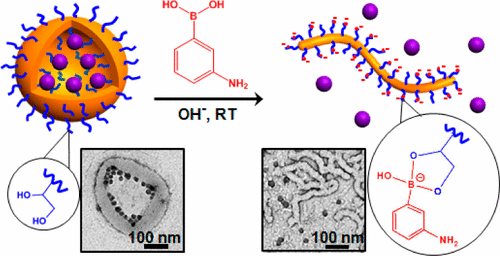当前位置:
X-MOL 学术
›
J. Am. Chem. Soc.
›
论文详情
Our official English website, www.x-mol.net, welcomes your
feedback! (Note: you will need to create a separate account there.)
Using Dynamic Covalent Chemistry To Drive Morphological Transitions: Controlled Release of Encapsulated Nanoparticles from Block Copolymer Vesicles
Journal of the American Chemical Society ( IF 14.4 ) Pub Date : 2017-05-12 00:00:00 , DOI: 10.1021/jacs.7b02642 Renhua Deng 1 , Matthew J. Derry 1 , Charlotte J. Mable 1 , Yin Ning 1 , Steven P. Armes 1
Journal of the American Chemical Society ( IF 14.4 ) Pub Date : 2017-05-12 00:00:00 , DOI: 10.1021/jacs.7b02642 Renhua Deng 1 , Matthew J. Derry 1 , Charlotte J. Mable 1 , Yin Ning 1 , Steven P. Armes 1
Affiliation

|
Dynamic covalent chemistry is exploited to drive morphological order–order transitions to achieve the controlled release of a model payload (e.g., silica nanoparticles) encapsulated within block copolymer vesicles. More specifically, poly(glycerol monomethacrylate)–poly(2-hydroxypropyl methacrylate) (PGMA–PHPMA) diblock copolymer vesicles were prepared via aqueous polymerization-induced self-assembly in either the presence or absence of silica nanoparticles. Addition of 3-aminophenylboronic acid (APBA) to such vesicles results in specific binding of this reagent to some of the pendent cis-diol groups on the hydrophilic PGMA chains to form phenylboronate ester bonds in mildly alkaline aqueous solution (pH ∼ 10). This leads to a subtle increase in the effective volume fraction of this stabilizer block, which in turn causes a reduction in the packing parameter and hence induces a vesicle-to-worm (or vesicle-to-sphere) morphological transition. The evolution in copolymer morphology (and the associated sol–gel transitions) was monitored using dynamic light scattering, transmission electron microscopy, oscillatory rheology, and small-angle X-ray scattering. In contrast to the literature, in situ release of encapsulated silica nanoparticles is achieved via vesicle dissociation at room temperature; moreover, the rate of release can be fine-tuned by varying the solution pH and/or the APBA concentration. Furthermore, this strategy also works (i) for relatively thick-walled vesicles that do not normally exhibit stimulus-responsive behavior and (ii) in the presence of added salt. This novel molecular recognition strategy to trigger morphological transitions via dynamic covalent chemistry offers considerable scope for the design of new stimulus-responsive copolymer vesicles (and hydrogels) for targeted delivery and controlled release of cargoes. In particular, the conditions used in this new approach are relevant to liquid laundry formulations, whereby enzymes require protection to prevent their deactivation by bleach.
中文翻译:

使用动态共价化学来驱动形态学转变:从嵌段共聚物囊泡中控制的封装纳米粒子的释放。
动态共价化学被用来驱动形态顺序转变,以实现对模型有效载荷(例如,二氧化硅纳米粒子)的控制释放,该有效载荷封装在嵌段共聚物囊泡中。更具体地,在存在或不存在二氧化硅纳米颗粒的情况下,通过水性聚合诱导的自组装来制备聚(甲基丙烯酸单甘油酯)-甲基丙烯酸2-羟丙基酯(PGMA-PHPMA)二嵌段共聚物囊泡。将3-氨基苯基硼酸(APBA)加到这些囊泡中,可使该试剂与亲水性PGMA链上的一些侧链顺式-二醇基团特异性结合,从而在弱碱性水溶液(pH约为10)中形成苯基硼酸酯键。这导致该稳定剂块的有效体积分数微妙增加,这反过来导致堆积参数降低,并因此引起囊泡到蠕虫(或囊泡到球体)的形态学转变。使用动态光散射,透射电子显微镜,振荡流变学和小角度X射线散射监测共聚物形态的演变(以及相关的溶胶-凝胶转变)。与文献相反,在室温下通过囊泡离解实现了被包封的二氧化硅纳米颗粒的原位释放。此外,可以通过改变溶液的pH值和/或APBA浓度来微调释放速率。此外,该策略还适用于(i)对于通常不表现出刺激响应行为的相对厚壁的囊泡,以及(ii)在添加盐的情况下。通过动态共价化学触发形态学转变的这种新颖的分子识别策略为设计新型刺激响应共聚物囊泡(和水凝胶)提供了广阔的空间,这些囊泡可用于目标递送和货物的受控释放。尤其是,这种新方法中使用的条件与液体衣物配方有关,因此需要对酶进行保护以防止其因漂白而失活。
更新日期:2017-05-24
中文翻译:

使用动态共价化学来驱动形态学转变:从嵌段共聚物囊泡中控制的封装纳米粒子的释放。
动态共价化学被用来驱动形态顺序转变,以实现对模型有效载荷(例如,二氧化硅纳米粒子)的控制释放,该有效载荷封装在嵌段共聚物囊泡中。更具体地,在存在或不存在二氧化硅纳米颗粒的情况下,通过水性聚合诱导的自组装来制备聚(甲基丙烯酸单甘油酯)-甲基丙烯酸2-羟丙基酯(PGMA-PHPMA)二嵌段共聚物囊泡。将3-氨基苯基硼酸(APBA)加到这些囊泡中,可使该试剂与亲水性PGMA链上的一些侧链顺式-二醇基团特异性结合,从而在弱碱性水溶液(pH约为10)中形成苯基硼酸酯键。这导致该稳定剂块的有效体积分数微妙增加,这反过来导致堆积参数降低,并因此引起囊泡到蠕虫(或囊泡到球体)的形态学转变。使用动态光散射,透射电子显微镜,振荡流变学和小角度X射线散射监测共聚物形态的演变(以及相关的溶胶-凝胶转变)。与文献相反,在室温下通过囊泡离解实现了被包封的二氧化硅纳米颗粒的原位释放。此外,可以通过改变溶液的pH值和/或APBA浓度来微调释放速率。此外,该策略还适用于(i)对于通常不表现出刺激响应行为的相对厚壁的囊泡,以及(ii)在添加盐的情况下。通过动态共价化学触发形态学转变的这种新颖的分子识别策略为设计新型刺激响应共聚物囊泡(和水凝胶)提供了广阔的空间,这些囊泡可用于目标递送和货物的受控释放。尤其是,这种新方法中使用的条件与液体衣物配方有关,因此需要对酶进行保护以防止其因漂白而失活。











































 京公网安备 11010802027423号
京公网安备 11010802027423号